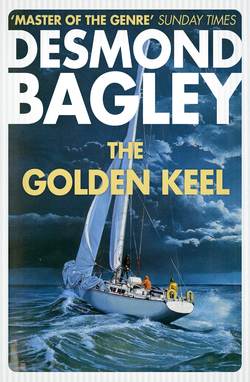Читать книгу The Golden Keel - Desmond Bagley, Desmond Bagley - Страница 8
ONE: WALKER
ОглавлениеMy name is Peter Halloran, but everyone calls me ‘Hal’ excepting my wife, Jean, who always called me Peter. Women seem to dislike nicknames for their menfolk. Like a lot of others I emigrated to the ‘colonies’ after the war, and I travelled from England to South Africa by road, across the Sahara and through the Congo. It was a pretty rough trip, but that’s another story; it’s enough to say that I arrived in Cape Town in 1948 with no job and precious little money.
During my first week in Cape Town I answered several of the Sit. Vac. advertisements which appeared in the Cape Times and while waiting for answers I explored my environment. On this particular morning I had visited the docks and finally found myself near the yacht basin.
I was leaning over the rail looking at the boats when a voice behind me said, ‘If you had your choice, which would it be?’
I turned and encountered the twinkling eyes of an elderly man, tall, with stooped shoulders and grey hair. He had a brown, weather-beaten face and gnarled hands, and I estimated his age at about sixty.
I pointed to one of the boats. ‘I think I’d pick that one,’ I said. ‘She’s big enough to be of use, but not too big for single-handed sailing.’
He seemed pleased. ‘That’s Gracia,’ he said. ‘I built her.’
‘She looks a good boat,’ I said. ‘She’s got nice lines.’
We talked for a while about boats. He said that he had a boatyard a little way outside Cape Town towards Milnerton, and that he specialized in building the fishing boats used by the Malay fishermen. I’d noticed these already; sturdy unlovely craft with high bows and a wheelhouse stuck on top like a chicken-coop, but they looked very seaworthy. Gracia was only the second yacht he had built.
‘There’ll be a boom now the war’s over,’ he predicted. ‘People will have money in their pockets, and they’ll go in for yachting. I’d like to expand my activities in that direction.’
Presently he looked at his watch and nodded towards the yacht club. ‘Let’s go in and have a coffee,’ he suggested.
I hesitated. ‘I’m not a member.’
‘I am,’ he said. ‘Be my guest.’
So we went into the club house and sat in the lounge overlooking the yacht basin and he ordered coffee. ‘By the way, my name’s Tom Sanford.’
‘I’m Peter Halloran.’
‘You’re English,’ he said. ‘Been out here long?’
I smiled. ‘Three days.’
‘I’ve been out just a bit longer – since 1910.’ He sipped his coffee and regarded me thoughtfully. ‘You seem to know a bit about boats.’
‘I’ve been around them all my life,’ I said. ‘My father had a boatyard on the east coast, quite close to Hull. We built fishing boats, too, until the war.’
‘And then?’
‘Then the yard went on to contract work for the Admiralty,’ I said. ‘We built harbour defence launches and things like that – we weren’t geared to handle anything bigger.’ I shrugged. ‘Then there was an air-raid.’
‘That’s bad,’ said Tom. ‘Was everything destroyed?’
‘Everything,’ I said flatly. ‘My people had a house next to the yard – that went, too. My parents and my elder brother were killed.’
‘Christ!’ said Tom gently. ‘That’s very bad. How old were you?’
‘Seventeen,’ I said. ‘I went to live with an aunt in Hatfield; that’s when I started to work for de Havilland – building Mosquitos. It’s a wooden aeroplane and they wanted people who could work in wood. All I was doing, as far as I was concerned, was filling in time until I could join the Army.’
His interest sharpened. ‘You know, that’s the coming thing – the new methods developed by de Havilland. That hot-moulding process of theirs – d’you think it could be used in boat-building?’
I thought about it. ‘I don’t see why not – it’s very strong. We did repair work at Hatfield, as well as new construction, and I saw what happens to that type of fabric when it’s been hit very hard. It would be more expensive than the traditional methods, though, unless you were mass-producing.’
‘I was thinking about yachts,’ said Tom slowly. ‘You must tell me more about it sometime.’ He smiled. ‘What else do you know about boats?’
I grinned. ‘I once thought I’d like to be a designer,’ I said. ‘When I was a kid – about fifteen – I designed and built my own racing dinghy.’
‘Win any races?’
‘My brother and I had ’em all licked,’ I said. ‘She was a fast boat. After the war, when I was cooling my heels waiting for my discharge, I had another go at it – designing, I mean. I designed half a dozen boats – it helped to pass the time.’
‘Got the drawings with you?’
‘They’re somewhere at the bottom of my trunk,’ I said. ‘I haven’t looked at them for a long time.’
‘I’d like to see them,’ said Tom. ‘Look, laddie; how would you like to work for me? I told you I’m thinking of expanding into the yacht business, and I could use a smart young fellow.’
And that’s how I started working for Tom Sanford. The following day I went to the boatyard with my drawings and showed them to Tom. On the whole he liked them, but pointed out several ways in which economies could be made in the building. ‘You’re a fair designer,’ he said. ‘But you’ve a lot to learn about the practical side. Never mind, we’ll see about that. When can you start?’
Going to work for old Tom was one of the best things I ever did in my life.
